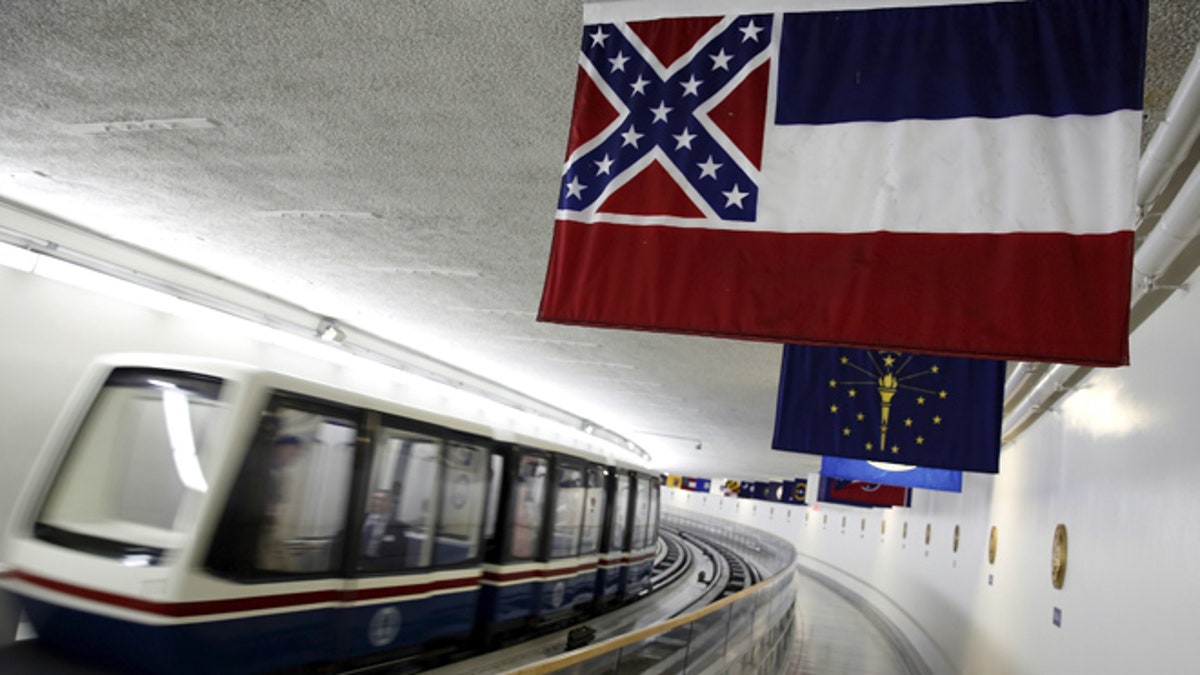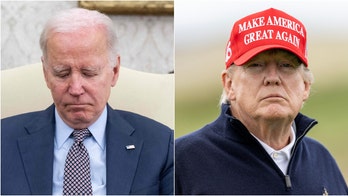
FILE: June 23, 2015: The Mississippi state flag still hangs among other state flags in the senate tunnel under the U.S. Capitol, in Washington, D.C. (REUTERS)
This is a story about flags, coins, congressional spending bills and a tunnel. But sometimes there’s more than meets the eye behind what appears to be a rather innocuous series of seemingly non-related events.
The Architect of the Capitol announced last September it would close off the tunnel that runs from the U.S. Capitol, under Independence Avenue and to the Rayburn House Office Building.
The memo declared that “construction will last for approximately one year with the majority of the work to take place nightly between the hours of 9:00 pm and 6:00 am.”
The AOC said the closure was necessary to renovate the tunnel’s ceiling, light fixtures, fire alarms and sprinklers.
And so as construction began, down came the flags of all 50 states, the District of Columbia and U.S. territories which embroidered the tunnel’s wall.
The tunnel looked pretty barren. The lack of flags accentuated the tunnel’s parabolic, curvature. The naked, vanilla wall still revealed a “shadow” of each flag and its state seal imprinted on the plaster. The exposed ceiling showed a network of nine parallel pipes running between the Capitol and Rayburn.
A few days ago, House Administration Committee Chairwoman Candice Miller, R-Mich., announced that the flags wouldn’t return when the tunnel’s work wrapped up. In place of the flags, the Architect of the Capitol would install reproductions of commemorative quarters issued by the U.S. Mint for all 50 states, the District of Columbia and U.S. territories.
“Each quarter serves as a reminder of the ideals, landmarks, and people from each state, as well as this nation’s great motto, ‘out of many, one,’” Miller said in a statement.
OK. No biggie. Just an aesthetic, “interior design” decision. Going for a different motif, right?
Perhaps.
But one of these flags was not like the others.
Forty-nine state flags seemed fine. But it was the flag from Mississippi that caused trouble.
Georgia adopted a new flag 13 years ago, dropping Confederate imagery. That left Mississippi as the only state emblem still depicting the Confederate battle flag. The upper left-hand corner of the banner features the deep blue cross cast against a red backdrop. Thirteen stars festoon the blue stripes.
The Mississippi flag has hung in the tunnel for years. A similar subterranean passageway stretching from the capitol and to the Dirksen and Hart Senate Office buildings continues to display the flags of all 50 states, including Mississippi.
But the Mississippi flag ignited a firestorm at the capitol after a massacre at the Emanuel African Methodist Church in Charleston, S.C. last June. Shooting suspect Dylann Roof later told police he began firing at black parishioners attending a Bible study in hopes of starting a race war.
A few days later, South Carolina GOP Gov. Nikki Haley ordered the removal of the Confederate flag from the state capitol. And Haley’s decision set into motion a whirlwind of issues in Congress as lawmakers tried to usher annual spending bills to passage.
Rep. Jared Huffman, D-Calif., crafted a little-known amendment to the appropriations bill that would fund the Interior Department. Huffman’s plan would prohibit the flying of the Confederate flag at many federal cemeteries. Without fanfare, the House approved Huffman’s amendment, hooking it the Interior spending bill.
But later the same night, Rep. Ken Calvert, R-Calif., introduced an amendment to counter Huffman -- apparently at the behest of the Republican leadership. The Calvert amendment would trump Huffman’s idea. As a result, the House scheduled a vote on the Calvert amendment and the full Interior Department spending bill the next day.
They couldn’t have picked a worse day. It was the same day Haley would preside over a ceremony removing the Confederate flag from the statehouse grounds.
The GOP brass worried it might not have the votes to pass the appropriations bill without attaching the Calvert amendment. Some Republicans simply couldn’t be on the record approving a bill that wiped out the display of the Confederate flag in federal cemeteries. By the same token, the optics were awful for the Republicans. They didn’t want to vote in favor of the Confederate flag just as Haley pulled down the Confederate flag.
The GOP yanked the entire Interior bill from the House calendar.
Then-House Speaker John Boehner, R-Ohio, wanted a compromise.
“I want members on both sides of the aisle to sit down, and let’s have a conversation about how to address what, frankly, has become a very thorny issue,” Boehner said.
It was at that point Democrats knew they had somewhat unintentionally marched House Republicans into a political box canyon.
Rep. Bennie Thompson, D-Miss., pushed a resolution to “remove any state flag containing any portion of the Confederate battle flag” from the House side of the capitol. However, the resolution included a carve-out for lawmakers to continue displaying the flag inside their offices if they chose to do so.
If the House adopted Thompson’s resolution, officials would have to remove the Mississippi flag from the Rayburn tunnel. The effort would force Republicans to take a tough vote -- or pay a political price for not doing so.
House Majority Leader Kevin McCarthy, R-Calif., punted the resolution so the House wouldn’t have to deal directly with Thompson’s initiative. The House voted with McCarthy, sidestepping a direct up or down vote.
But while Republicans could a skirt a vote on the resolution, they couldn’t avoid the issue.
Democrats repeatedly tried to push a vote on Thompson’s resolution without success. Republicans knew how embarrassing the outcome of the issue would be: The House would most likely defeat the resolution.
That would help Democrats portray individual lawmakers -- now on the record on a specific roll call vote -- as voting in favor of maintaining the Mississippi flag. People would cry racism. Callousness. You name it. All of the things Republicans struggle with as a party that performs poorly with minority voters.
There was residual impact, too. Democrats made it clear they would try to hook a version of the Huffman amendment onto any of the remaining appropriations bills.
Variations of Huffman’s plan might not pertain directly to flying Confederate flags at federal cemeteries. But Democrats could sure include an amendment to ban the display of such a symbol at any other federal facility governed by the remaining spending measures.
Thus, the appropriations process ground to a halt. Republicans couldn’t risk taking a vote on such a toxic issue. The House put the appropriations cycle on ice until winter.
The maintenance of the Rayburn tunnel was long planned before this political dustup.
But last year, multiple sources confided in Fox that the timing and removal of the flags may prove fortuitous. With the refurbishment of the tunnel slated to run through this September, there was hope that the Mississippi legislature would vote to change the flag in its next session.
The Mississippi legislature concluded its 2016 session with multiple bills to redesign the state flag falling by the wayside.
Back in Washington, lawmakers stared at the start of annual appropriations bills in just a few weeks and a naked wall lining the Rayburn tunnel.
Could the summer of 2016 be a repeat of the summer of 2015?
That’s when Miller engineered the state coin idea, mothballing the flags.
“Given the controversy surrounding Confederate imagery, I decided to install a new display,” she said. “I am well aware of how many Americans negatively view the Confederate flag. And, personally, I am very sympathetic to these views. However, I also believe that it is not the business of the federal government to dictate what flag each state flies.”
And so the installation of the commemorative quarters.
As Miller says, each U.S. quarter is emblazoned with the phrase “E Pluribus Unum,” which means “out of many, one.”
The protracted banishment of the Mississippi flag forced the removal of all state flags from the Rayburn tunnel.
That would be “E Pluribus Non,” which means “out of many, none.”




